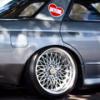R32 Hicas Removal
Announcements
-
Similar Content
-
Latest Posts
-
My return flow is custom and puts the return behind the reo, instead of at the bottom. All my core is in the air flow, rather than losing some of it up behind the reo. I realise that the core really acts more as a spiky heatsink than as a constant rate heat exchanger, and that therefore size is important.... but mine fits everything I needed and wanted without having to cut anything, and that's worth something too. And there won't be a hot patch of core up behind the reo after every hit, releasing heat back into the intake air.
-
By Murray_Calavera · Posted
There is a really fun solution to this problem, buy a Haltech (or ECU of your choice) and put the MAF in the bin. I'm assuming your going to want more power in future, so you'll need to get the ECU at some stage. I'd put the new MAF money towards the new ECU. -
By MissMintyR33 · Posted
Any idea where I can get genuine MAF apart from used ones? I can't find any only for GTRs and unfortunately that price is not in my budget 🤣 I might gap my plugs down and put my splitfires in, they were only in for a year or so before I started the rebuild -
By Murray_Calavera · Posted
Lots of bad aftermarket MAF's exist unfortunately. Lots of bad aftermarket coil packs exist as well. I'm not familiar with savage performance coil packs but I wouldn't bet on them being amazing. -
By MissMintyR33 · Posted
Hopefully this video loads, this was a month ago, it isn't as bad now (with the back fire) it's more of a hesitation at certain RPMs Snapchat-1404613580.mp4
-



Recommended Posts
Create an account or sign in to comment
You need to be a member in order to leave a comment
Create an account
Sign up for a new account in our community. It's easy!
Register a new accountSign in
Already have an account? Sign in here.
Sign In Now